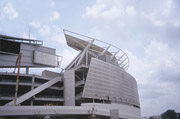Are You Ready For Some Football?

Building a $420 million dollar football stadium was bound to be complicated. Oh sure, there are the 9,100 tons of structural steel, 95,000 cubic yards of concrete, 1,200 doors, 1,200 restroom fixtures, 400 food outlets, and of course, 28 different roofs. But that’s only part of it.
The Fray
The real intrigue with Paul Brown Stadium, the new home for the Cincinnati Bengals, started even before the groundbreaking festivities in April 1998. The Cliff’s Notes version of the story? As reported in the Cincinnati Enquirer, the Bengals threatened to move out of Cinci way back in 1993 if they didn’t get a new stadium. The team didn’t reach an agreement with the city until the following year, and the deal included a new baseball stadium for the Reds as well. But then came the always-enjoyable task of figuring out where the money would come from. The responsibility eventually fell to Hamilton County, which then had a minor dispute (including a ballot initiative), over raising the sales tax. By now it was 1996, and this was a problem: If the stadium wasn’t done by August 2000, taxpayers were required to fork over millions of dollars for every game the Bengals had to play at Cinergy Field, their former home that they shared with the Reds.The county didn’t sign a lease with the Bengals until May 1997, and the preliminary “guaranteed maximum price” of $287 million wasn’t announced until November of that same year. The amount seemed to be more than expected, and it wasn’t “accepted” until April of 1998. What this accomplished was anyone’s guess, since the guaranteed maximum price ended up being merely a guess, and certainly not guaranteed.
In the meantime, more arguments over where exactly the stadium was going to be, as well as some bad weather, meant further delays.
But wait, there’s more! Stadium construction started on the fast track, and so did the cost overruns. The extent of the problem became apparent to Hamilton County officials at the end of 1999, so they hired PriceWaterhouseCoopers as an independent auditor to review all of the change orders. The investigation found no evidence of fraud or theft, rather, the estimated $45 million dollars in cost overruns were due to the schedule, poor oversight and haphazard record keeping. And everyone got a share of the blame: the Bengals, the county commissioners, NBBJ (the architect), Turner/Barton Malow/D.A.G. (the construction manager, a joint venture formed specifically to work on the stadium), and Getz Ventures (the project manager). Contractors will probably be paid, but the county may try to sue later to get some of its money back. As of press time, the stadium was predicted to be open, but not quite done, for the Bengals’ first preseason game against the Chicago Bears on August 17th.
Team Player
The good news in all of this, as far as roofing is concerned, is that the 28 roofs were not part of the cost overruns. And better yet, the company on the job knows its stuff. The Imbus Roofing Co. Inc., Wilder, Ky., does all types of commercial and industrial roofing, as well as a lot of historic restoration. Imbus will even take on a residential job if specialty work with slate, tile or stone is required. In fact, Imbus worked on the Bengals’ original stadium back in 1975-6.What’s even more amazing is that Imbus Roofing has been around in one form or another for nearly 130 years. It all started in Cincinnati with Henry Imbus and Fred Ralling’s Stove Store and Tin Shop back in 1873. The company kept growing and changing, and by 1939 it was Imbus Brothers Roofing and Sheet Metal.
Obviously dedicated to their business, the Imbus men have always been involved in the community and the industry as well. Ed Imbus, Henry’s son, was elected to the city council in 1932 and served as its president until 1937. Eugene Imbus Sr., Ed’s son, was part of a group of businessmen who established a school to promote the education of minorities. He also supported a local seminary that specialized in educating priests for travel to South Africa to perform missionary work.
As far as the industry is concerned, Eugene served as a director of the Allied Construction Industries, representing roofing contractors. Current company president Eugene Imbus Jr. began working for his father in 1946. He also served on the board of directors for ACI and was president from 1967-69. He was a member of the employers’ committee that established the Composition Roofers Pension Plan for the Local 42 Roofers Union of Greater Cincinnati and continues to serve as a trustee.
Eugene Jr.’s son Jim started with the company in 1976. In addition to his administrative duties as vice president, he acts as estimator and job superintendent. Like his father and grandfather, Jim is on the board of ACI and is also its secretary and a member of the executive committee. He has been president of the Greater Cincinnati Roofing Contractors Association since 1994. When asked what has kept Imbus Roofing going all of these years, Jim responds, “We love the work we do and we do a good job.” He adds, “We specialize in ‘old-time’ roofing work like sheet metal, cornices, copper, tile and slate. We get a lot of replacement work from roofs the company installed 30 or 40 years ago.” Jim has three sons, so it’s probably safe to assume that the family name in roofing will be carried on.

Play by Play
How did Imbus Roofing get involved in the Paul Brown Stadium project? It certainly helped that the company has often worked with Barton Malow Co., the construction manager. The two firms have a good relationship — they even collaborated on the original stadium job. For the current project, “We helped them out with budget figures a couple years ago before the drawings came out,” explains Imbus, “and then we ended up being low on the competitive bid.”Imbus Roofing’s contract is for $400,000, but it might end up being $450,000 when all is said and done. Paul Brown Stadium is open air, so the job calls for 28 different single-ply roofs. The mechanically attached roofs over concession stands, restrooms and the party suites totaled 448 squares. The largest roof being done is a 185-square vented system over the administration building.
The specifications didn’t call for a particular product, so Imbus promoted the use of Stevens EP TPO. Stevens EP is a reinforced, heat-weldable, ethylene propylene-based material manufactured from a proprietary TPO compound from Montell USA Inc., Some benefits of this product include the weatherability of an ethylene propylene membrane and the strength and speed of hot-air-welded seams. The roofs at Paul Brown Stadium are white TPO, and this also offers energy reflectivity while avoiding the problems associated with plasticizer migration or membrane shrinkage.
“It’s a good system that can be used in different ways,” Imbus explains. The roofs over metal decks on the stands and restrooms could be mechanically attached, but the concrete decking on the administration building presented a different challenge. This area required a vented roofing system. In a standard system, high winds can create an inequality in pressure, resulting in a billowing effect, which, in extreme cases, can cause roof damage. A vented roofing system uses one-way valves to let air pressure out, but not in. On the administration building, the TPO is air sealed to the concrete with valves placed on the perimeter. The aerodynamic suction occurring across the roof is transferred underneath the roof membrane, thus sucking the membrane down to the sealed substrate.
The vented roofing system concept was developed by Tom Kelly of 2001 Co., which holds the patent. Stevens is one of a few manufacturers using the technology. The company sends a technical person to each job to closely watch the process. “We provide training onsite for every job,” says Michael Thornton, technical review manager at Stevens. “Every job requires onsite tweaking. We have basic guidelines for placement and number of valves from 2001 Company, and then we apply our own formulas to make sure our requirements are met. The process is very job specific, taking into consideration building elevation, length of its sides and parapet heights.”
Art Tafil, southeastern technical sales regional manager for 2001 Co. explains the different reasons for using a vented roofing system: “Aside from solving problems in high wind areas, vented roofing systems offer ease of installation and tremendous labor savings, especially if you want to avoid drilling through a concrete deck. The system also has the incidental benefit of drying out a roof, which can sometimes be done if you don’t want to do a complete tear-off.”
Two-Minute Warning
So did the stadium saga make life difficult for Imbus Roofing? “Not really,” says Imbus “Yes, there have been change orders, extras and cost overruns, mostly due to trying to get the job done in a hurry. They started pouring concrete before the drawings were done. Our biggest challenge was putting on 28 roofs before the August 17th deadline. We started three months later than the plan called for.”Additional challenges included often having to go back and redo flashings and other parts of the roofs, since, as Imbus explains, “The mechanical guys came in after us.” In addition, Imbus had to coordinate four to five crews at a time. Not all of the company’s employees are experienced with heat-welded single ply, since they mostly work with BUR. Making sure someone with experience was on each crew was crucial. As far as safety concerns, Imbus says that Turner Barton Malow wanted everyone 100 percent tied off. “This was a lot easier to accomplish with a TPO system than it would have been with BUR.”
Most likely the fans that arrive for the preseason opener won’t be paying much attention to the benefits of TPO and vented roofing systems. They just want to see their team live up to the splendor of the new stadium, and maybe, crush the Cleveland Browns in the first regular season game. And while parts of the building may be lacking a coat of paint and some other finishing touches, the roofs will be done on time. It’s all part of Jim Imbus’ philosophy of success. “Enjoy your work and the people you work, do a good job, get the job done on time and maintain a comfortable profit margin.”
Looking for a reprint of this article?
From high-res PDFs to custom plaques, order your copy today!




